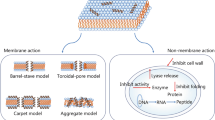Abstract
Cationic antimicrobial peptides (CAPs) are essential components of the innate immune system. Most CAPs exert antimicrobial effects via membrane-active mechanisms, while high concentrations of CAPs are associated with non-selective cytotoxicity. We originally hypothesized that a sub-lethal concentration of CAPs was able to exert antibacterial activity, by interacting with negatively charged nucleic acids, and not by damaging bacterial membranes. We selected pleurocidin (Ple) and Escherichia coli as experimental models of CAPs and bacteria, respectively. Whereas Ple distinctly acted on bacterial membranes in a concentration-dependent manner, the cell viability was almost similar regardless the peptide concentration. To address how Ple retained its antibacterial activity in a low concentration, we particularly focused on the induction of intracellular apoptosis-like death (ALD). Finally, it was suggested that a sub-lethal concentration of Ple led to ALD in E. coli, mediated by caspase-like protein and RecA. To the best of our knowledge, this is the first study showing that alterations of CAP mechanisms are concentration dependent in bacteria.




Similar content being viewed by others
References
Choi H, Lee DG (2012) Antimicrobial peptide pleurocidin synergizes with antibiotics through hydroxyl radical formation and membrane damage, and exerts antibiofilm activity. Biochim Biophys Acta 1820:1831–1838
Cole AM, Weis P, Diamond G (1997) Isolation and characterization of pleurocidin, antimicrobial peptide in the skin secretions of winter flounder. J Biol Chem 272:12008–12013
Courcelle J, Khodursky A, Peter B, Brown PO, Hanawalt PC (2001) Comparative gene expression profiles following UV exposure in wild-type and SOS-deficient Escherichia coli. Genetics 158:41–64
Creagh EM (2014) Caspase crosstalk: integration of apoptotic and innate immune signalling pathways. Trends Immunol 35:631–640
Cruz J, Ortiz C, Guzmán F, Fernández-Lafuente R, Torres R (2014) Antimicrobial peptides: promising compounds against pathogenic microorganisms. Curr Med Chem 21:2299–2321
Dwyer DJ, Camacho DM, Kohanski MA, Callura JM, Collins JJ (2012) Antibiotic-induced bacterial cell death exhibits physiological and biochemical hallmarks of apoptosis. Mol Cell 46:561–572
Erental A, Kalderon Z, Saada A, Smith Y, Engelberg-Kulka H (2014) Apoptosis-like death, an extreme SOS response in Escherichia coli. MBio 5:e01414–e01426
Fernández De Henestrosa AR, Ogi T, Aoyagi S, Chafin D, Hayes JJ, Ohmori H, Woodgate R (2000) Identification of additional genes belonging to the LexA regulon in Escherichia coli. Mol Microbiol 35:1560–1572
González IJ, Desponds C, Schaff C, Mottram JC, Fasel N (2007) Leishmania major metacaspase can replace yeast metacaspases in programmed cell death and has arginine specific cysteine peptidase activity. Int J Parasitol 37:161–172
Hancock RE (1999) Host defence (cationic) peptides: what is their future clinical potential? Drugs 57:469–473
Hengartner MO (2000) The biochemistry of apoptosis. Nature 407:770–776
Hwang PM, Vogel HJ (1998) Structure-function relationships of antimicrobial peptides. Biochem Cell Biol 76:235–246
Jung HJ, Park Y, Sung WS, Suh BK, Lee J, Hahm KS, Lee DG (2007) Fungicidal effect of pleurocidin by membrane-active mechanism and design of enantiomeric analogue for proteolytic resistance. Biochim Biophys Acta 1768:1400–1405
Koch G, Yepes A, Förstner KU, Wermser C, Stengel ST, Modamio J, Ohisen K, Foster KR, Lopez D (2014) Evolution of resistance to a last-resort antibiotic in Staphylococcus aureus via bacterial competition. Cell 158:1060–1071
Koopman G, Reutelingsperger CP, Kuijten GA, Keehnen RM, Pals ST, van Oers MH (1994) Annexin V for flow cytometric detection of phosphatidylserine expression on B cells undergoing apoptosis. Blood 84:1415–1420
Maher S, McClean S (2008) Melittin exhibits necrotic cytotoxicity in gastrointestinal cells which is attenuated by cholesterol. Biochem Pharmacol 75:1104–1114
Maloy WL, Karl UP (1995) Structure-activity studies on magainins and other host defense peptides. Biopolymers 37:105–122
Merrifield B (1986) Solid phase synthesis. Science 232:341–347
Pandey BK, Srivastava S, Singh M, Ghosh JK (2011) Inducing toxicity by introducing a leucine-zipper-like motif in frog antimicrobial peptide, magainin 2. Biochem J 436:609–620
Saint N, Cadiou H, Bessin Y, Molle G (2002) Antibacterial peptide pleurocidin forms ion channels in planar lipid bilayers. Biochim Biophys Acta 1564:359–364
Schmidt NW, Wong GC (2013) Antimicrobial peptides and induced membrane curvature: geometry, coordination chemistry, and molecular engineering. Curr Opin Solid State Mater Sci 17:151–163
Yoshida K, Mukai Y, Niidome T, Takashi C, Tokunaga Y, Hatakeyama T, Aoyagi H (2001) Interaction of pleurocidin and its analogs with phospholipid membrane and their antibacterial activity. J Pept Res 57:119–126
Acknowledgments
This work was supported by a Grant from the Next-Generation BioGreen 21 Program (No. PJ01104303), by the Rural Development Administration (Republic of Korea).
Author information
Authors and Affiliations
Corresponding author
Rights and permissions
About this article
Cite this article
Lee, J., Lee, D.G. Concentration-Dependent Mechanism Alteration of Pleurocidin Peptide in Escherichia coli . Curr Microbiol 72, 159–164 (2016). https://doi.org/10.1007/s00284-015-0937-0
Received:
Accepted:
Published:
Issue Date:
DOI: https://doi.org/10.1007/s00284-015-0937-0




